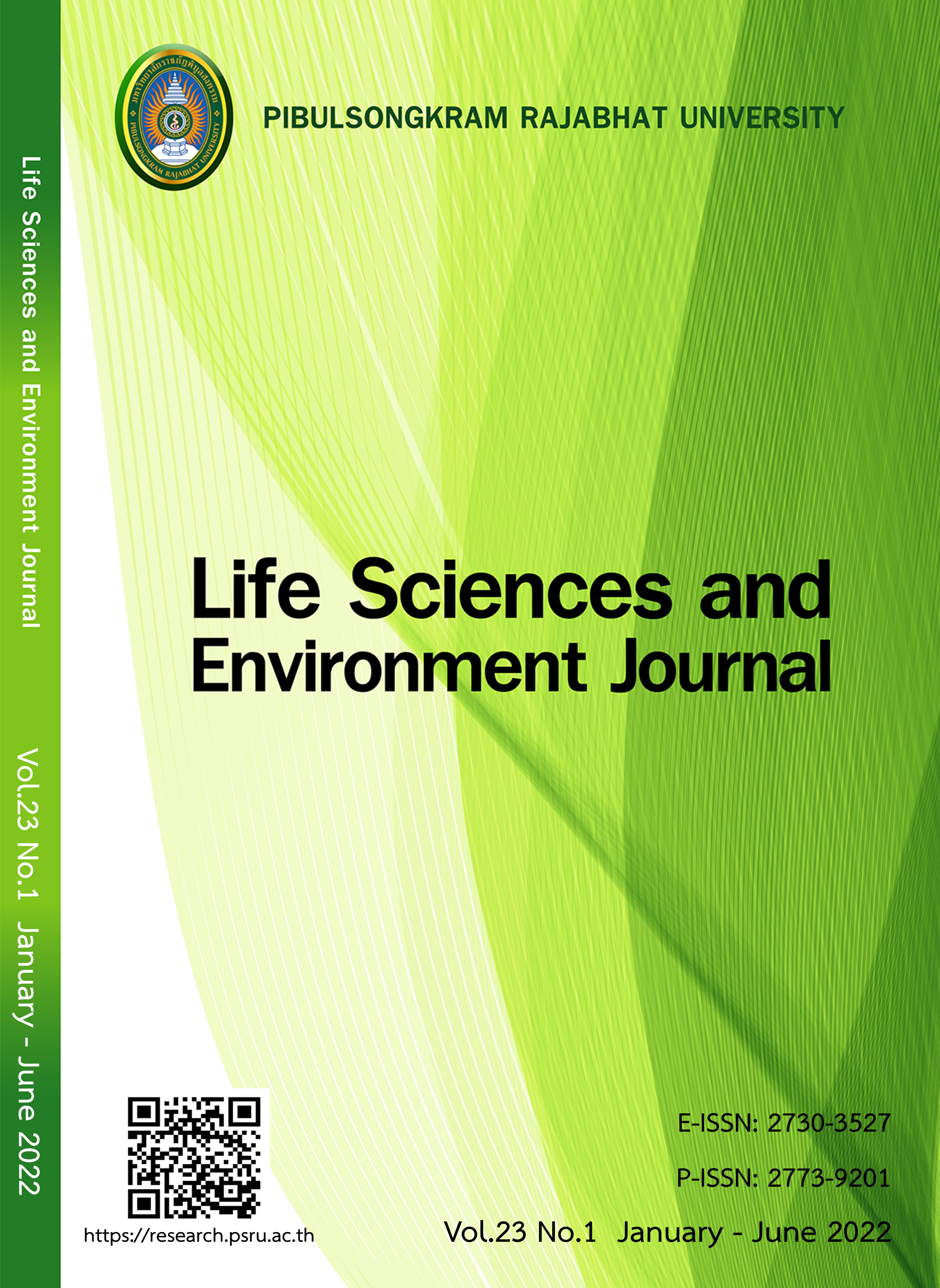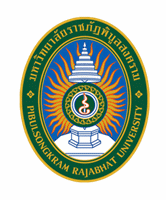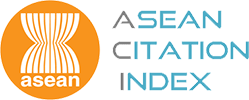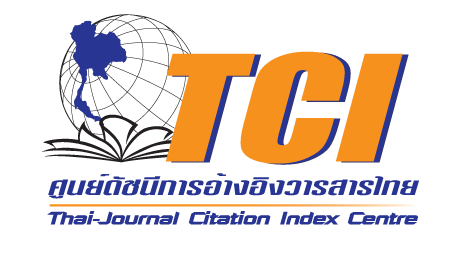องค์ประกอบทางเคมีในสารสกัดจากเถาแห้มกับประสิทธิภาพการลดปริมาณสารเคมีกำจัดศัตรูพืชคลอร์ไพริฟอสตกค้างในถั่วฝักยาว
DOI:
https://doi.org/10.14456/lsej.2022.10คำสำคัญ:
แห้ม, การล้างสารกำจัดศัตรูพืชตกค้าง , คลอร์ไพริฟอส , เบอร์บีรีน , ถั่วฝักยาวบทคัดย่อ
การลดปริมาณสารเคมีกำจัดศัตรูพืชในผักโดยใช้สารสกัดจากพืชธรรมชาติเป็นทางเลือกที่เป็นมิตรต่อสิ่งแวดล้อม งานวิจัยนี้ศึกษาการลดปริมาณสารคลอร์ไพริฟอสตกค้างในถั่วฝักยาวด้วยสารสกัดจากเถาแห้มและศึกษาองค์ประกอบทางเคมีในสารสกัดแห้ม โดยการนำเถาแห้มมาสับและสกัดสาร
ด้วยวิธีการหมักเย็น เพิ่มความเข้มข้นของสารสกัดโดยใช้เครื่องระเหยสารแบบหมุนภายใต้สุญญากาศและทำแห้งแบบเยือกแข็ง ละลายสารสกัดด้วยน้ำที่ความเข้มข้นต่าง ๆ นำไปแช่ถั่วฝักยาวที่ปนเปื้อนสารคลอร์ไพริฟอส ตรวจวิเคราะห์สารพิษด้วยชุดทดสอบสารกลุ่มออการ์โนฟอสเฟต-คาร์บาเมต (GT-test kit) ตรวจยืนยันปริมาณสารคลอร์ไพริฟอสด้วยเทคนิคก๊าซโครมาโทกราฟแมสสเปกโทรเมตรี ผลการศึกษาพบว่าการสกัดแห้มด้วยเอทานอลมีประสิทธิภาพสูงสุดในการลดปริมาณสารพิษตกค้าง แต่การสกัดด้วยน้ำเป็นวิธีที่สะดวกและให้ผลผลิตมากกว่า การสกัดด้วยเอทานอลและน้ำได้ผลผลิต 1.80 และ 9.72%w/w ตามลำดับ สารสกัดแห้มจากเอทานอลระยะเวลาการหมัก 48 ชั่วโมง ความเข้มข้น 45%w/v และระยะเวลาการล้างสารพิษ 10 นาที ให้ประสิทธิภาพสูงสุดในการล้างสารคลอร์ไพริฟอส โดยตรวจไม่พบสารพิษตกค้าง
การตรวจยืนยัน พบว่า ประสิทธิภาพในการลดสารคลอร์ไพริฟอสของสารสกัดแห้มด้วยเอทานอลเท่ากับ 99.02% ผลการวิเคราะห์องค์ประกอบทางเคมีในสารสกัดแห้มด้วยเอทานอลและน้ำพบสาร Oleyl Alcohol และ 2,3-Butylene glycol มากที่สุด ตามลำดับ การตรวจวิเคราะห์ปริมาณสาร Berberine ในสารสกัดแห้มด้วยเอทานอลพบในปริมาณสูงกว่าการสกัดด้วยน้ำ
References
Adachi A, Okano T. Pesticide residue reduction in selected vegetables using rice-bran. Journal of Health Science 2006;52(3):320-323.
Gouri S, Yogesh K, Tyagi R, Kumar G. Removal of Organophosphorus (OP) pesticide residues from vegetables using washing solutions and boiling. Journal of Agricultural Science 2012;4(2):69-78.
HafizUbaid UR, Waqas A, Wahab N, Mansur AS, Anwaar AN. A comprehensive review on chlorpyrifos toxicity with special reference to endocrine disruption: Evidence of mechanisms, exposures and mitigation strategies. Science of The Total Environment 2021;755(2):142-149.
Hattori M, Nakabayashi T, Lim Y. Inhibitory effect of various ayuravedic and panamanian medicinal plants on the infection of herpes simplex virus-I in vitro and in vivo. Phytotherapy Research 1995;9(4):270-276.
Singh GB, Singh S, Malhotra S. Hypotensive action of Coscinium fenestratum stem extract. Journal of Ethnopharmacology 1990;30(2):151-155.
Jiguo W, Tiangang L, Chongyu L, Thomas WL, Gilbert YS. Removal of residual pesticides on vegetable using ozonated water. Food Control 2007;18(5):466-472.
Jinwang L, Guofang P, Fazheng R, Bing F. Chlorpyrifos-induced reproductive toxicity in rats could be partly relieved under high-fat diet. Chemosphere 2019;229(1):94-102.
Keawpradub S. The alkaloids from the stems of Cosciniun fenestratum (Gaertn.) Colebr. Master degree thesis. Chulalongkorn University, Thailand; 1992.
Klaus EA, Sigurd BO. Allergic contact dermatitis from oleyl alcohol in Elidel® cream. Contact Dermatitis 2006;55(6):354-356.
Masruri S, Warsito M, Adi P. Renewable oil extracted from Indonesian Srikaya’s (Annona squamosal sp.) seed: another potent source for biodiesel. The Journal of Pure and Applied Chemistry Research 2012:1(1);51-57.
Palasuntheram C, Lyer KS, De Silva LB, De SilvaT. Antimicrobial activity of Coscinium fenestratum Colebr. against Clostridium tetani, Indian Journal of Medical Research 1982;76(1):71-76.
Pinho PMM, Pinto MMM, Kijjoa A, Pharadai K, Diaz JG, Herz W. Protoberberine alkaloids from Cosciniun fenestratum, Phytochemistry 1992;31(4):1403-1407.
Rojsanga P, Gritsanapan W, Suntornsuk L. Determination of berberine content in the stem extracts of Coscinium fenestratum by TLC Densitometry. Medical Principles and Practice 2006;15(5):373-378.
Tawee R. Detoxification of organophosphate and carbamate by Thai herbal plants. Bachelor degree thesis. Boromarajonani College of Nursing Chiang Mai, Thailand; 2010.
Tha-in S, Dau HA, Dumri K. The enhanced carbamate adsorption of modified bentonite with Coscinium fenestratum. International Journal of Environmental Science and Development 2013;4(4):415-418.
Tushar KV. Coscinium fenestratum (Gaertn.) Colebr. A review on this rare, critically endangered and highly-traded medicinal species. Journal of Plant Sciences 2008;3(2):133-145.
Downloads
เผยแพร่แล้ว
How to Cite
ฉบับ
บท
License
Copyright (c) 2022 Life Sciences and Environment Journal

This work is licensed under a Creative Commons Attribution-NonCommercial-NoDerivatives 4.0 International License.
Each article is copyrighted © by its author(s) and is published under license from the author(s).









